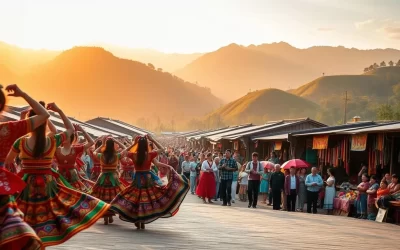Nestled in the southwestern part of a vast country, this area is a treasure trove of cultural and linguistic diversity. Its capital, Guiyang, serves as the heart of this vibrant region, home to millions of people who contribute to its dynamic identity.
The region’s linguistic landscape is as varied as its geography. From the dominant Mandarin to the intricate tones of Cantonese, each language and dialect tells a story of its people and their history. This diversity is not just a cultural marker but also an economic resource, driving growth and development.
Understanding the languages spoken here offers a window into the lives of different groups. Whether you’re exploring the bustling streets of Guiyang or the serene countryside, the dialects you encounter reflect the area’s rich heritage. Dive in to discover how language shapes this unique region.
Introduction to Guizhou’s Linguistic Landscape
The linguistic diversity of this southwestern region reflects its rich cultural tapestry. With 54 of the country’s 56 ethnic groups calling it home, the area is a melting pot of traditions and dialects. This variety is not just a cultural marker but also a vital part of its identity.
Discovering the Region’s Cultural Heritage
Languages here are deeply tied to the cultural heritage of its people. From ancient traditions to modern practices, each dialect tells a story. For example, Guizhou Forerunner College (GFC) emphasizes local knowledge by offering courses in traditional crafts like batik and embroidery. This approach helps preserve the region’s unique identity.
Why You Should Explore Guizhou’s Languages
Exploring these languages offers a deeper understanding of the population and their way of life. Government initiatives, like the Bai Niao He Digital Town, aim to enhance economic and social benefits through big data development. These efforts highlight the importance of preserving linguistic diversity while fostering growth.
| Aspect | Details |
|---|---|
| Ethnic Groups | 54 of 56 represented |
| Key Initiative | Bai Niao He Digital Town |
| Focus | Big data and cultural preservation |
Understanding the languages of this part of the country is more than an academic exercise. It’s a way to connect with the people and their stories. Whether you’re exploring bustling cities or serene villages, the dialects you encounter will enrich your experience.
Historical Evolution of Languages in Guizhou
The history of language in this region is a fascinating journey through time, shaped by dynasties, migrations, and cultural exchanges. Over centuries, the country’s linguistic landscape has evolved, reflecting the influences of its rulers and neighbors. From ancient kingdoms to imperial China, each era left its mark on the local dialects and scripts.

Ancient Roots and Dynastic Influences
Long before this area became part of imperial China, it was home to the Dian Kingdom. Early language systems here were influenced by neighboring cultures and trade routes. The incorporation into the Han dynasty brought Chinese characters, which became a cornerstone of written communication.
Dynastic changes, like the Ming Dynasty’s establishment in 1413, further shaped the linguistic identity. These shifts introduced new dialects and reinforced the use of Mandarin as a unifying language.
The Role of Migration and Historical Events
Migration played a key role in shaping the language landscape. People from different parts of the world brought their dialects, enriching the region’s linguistic diversity. Historical events, such as rebellions and border conflicts, also influenced language use.
Strategic border locations facilitated cultural exchanges with neighboring countries. These interactions introduced new words and expressions, blending them into local dialects.
| Event | Impact on Language |
|---|---|
| Dian Kingdom | Early language systems developed |
| Han Dynasty | Introduction of Chinese characters |
| Ming Dynasty | Reinforcement of Mandarin |
| Migration | Enriched linguistic diversity |
Understanding this historical evolution gives you a deeper appreciation of the region’s linguistic richness. It’s a testament to how language adapts and thrives through time and change.
Geographical Influences on Language Diversity
Geography plays a pivotal role in the linguistic diversity found here. The rugged terrain, including the Yungui Plateau and towering peaks like Jiucaiping, has created natural barriers. These barriers have fostered distinct language variations over time.
High mountain ranges have isolated communities, allowing archaic elements of the chinese language to survive. In these highland regions, dialects have remained untouched by external influences for centuries. This isolation has preserved unique linguistic features that might have otherwise disappeared.
The area’s strategic location has also influenced its linguistic identity. Natural barriers like rivers and valleys have shaped how communities communicate. This has led to a rich variety of dialects, each reflecting the geography of its speakers.
Over the centuries, this isolation has enhanced the region’s linguistic diversity. The mountains have acted as a natural protector of heritage, ensuring that each community retains its unique voice. This makes the area a fascinating study in how geography shapes language.
Guizhou Province, China: Official and widely spoken languages
The dominance of Mandarin in this area reflects centuries of historical and political influence. As the official language, it serves as a unifying medium across diverse ethnic groups. This linguistic prominence is deeply rooted in the region’s past, shaped by dynastic policies and modern governance.
Mandarin’s Role in Unifying Communities
Mandarin, particularly Southwestern Mandarin, has become the primary language here. Government policies have actively promoted its use to foster national unity. This approach ensures that all communities, regardless of their minority languages, can communicate effectively.
Historical dynasties played a significant role in standardizing Mandarin. From the Han to the Ming, rulers allocated resources to develop and promote a common language. This legacy continues today, shaping both education and daily interactions.
Coexistence of Minority Languages
Despite Mandarin’s dominance, minority languages thrive in this region. Over 37% of the population belongs to minority groups, each preserving their unique dialects. This coexistence reflects the area’s commitment to cultural diversity.
Schools often teach both Mandarin and local dialects, ensuring that younger generations remain connected to their heritage. This dual approach balances national unity with cultural preservation.
“Language is not just a tool for communication; it’s a bridge that connects the past to the present.”
| Aspect | Details |
|---|---|
| Primary Language | Southwestern Mandarin |
| Minority Groups | Over 37% of the population |
| Educational Focus | Bilingual teaching (Mandarin & local dialects) |
| Historical Influence | Dynastic policies on language standardization |
Understanding Mandarin’s prevalence offers insight into the region’s cultural and political dynamics. It’s a testament to how language can unite diverse communities while preserving their unique identities.
Mandarin Chinese and Regional Dialects in Guizhou
Southwestern Mandarin serves as a linguistic bridge, connecting millions across diverse communities. Its prominence in daily communication reflects centuries of historical development and cultural exchange. This dialect plays a vital role in unifying people while preserving regional identities.
Understanding Southwestern Mandarin
Southwestern Mandarin is spoken by over 260 million people, making it one of the most widely used dialects. Its influence spans regions like Sichuan, Yunnan, and Guangxi, where it serves as a common language for communication. This dialect retains four of the eight tones from Late Middle Chinese, showcasing its rich linguistic history.
In urban areas, Southwestern Mandarin has become the primary language for education and business. Its growth reflects the region’s evolving system of communication. Despite its widespread use, local variations add depth to its linguistic diversity.
Local Dialect Variations and Their Significance
Local dialects add a unique flavor to the region’s linguistic tapestry. These variations often reflect the history and culture of specific communities. For example, the Chengdu-Chongqing dialects preserve aspects of Ming Dynasty Mandarin, offering a glimpse into the past.
Efforts to preserve these dialects are evident in educational settings. Schools often teach both Mandarin and local languages, ensuring younger generations stay connected to their heritage. This approach fosters a strong sense of community while promoting national unity.
Understanding these variations helps you appreciate the region’s cultural richness. Whether you’re exploring bustling cities or rural villages, the dialects you encounter tell stories of resilience and identity.
Minority Languages and Ethnic Diversity
The vibrant mosaic of minority languages in this region reflects its deep cultural roots. With over 40 ethnic groups, each community contributes to the linguistic richness that defines the area. This diversity is not just a cultural marker but a living testament to the region’s heritage.

Languages Spoken by the Miao, Bouyei, Dong, and Others
The Miao, Bouyei, and Dong communities are among the most prominent minority groups here. The Miao, making up 12% of the population, speak a language that is part of the Hmong-Mien family. Similarly, the Bouyei and Dong languages, spoken by 8% and 5% respectively, add to the linguistic tapestry of the region.
These languages are more than just a means of communication. They carry the culture and history of their people. For example, Miao songs and Bouyei folk tales are integral to their identity. This connection between language and heritage is what makes these communities unique.
Han Chinese Influence and Preservation Efforts
While minority languages thrive, the influence of Han Chinese is undeniable. As the majority group, Han Chinese has shaped the linguistic landscape of the nation. However, efforts to preserve minority languages are ongoing. Schools often teach both Mandarin and local dialects, ensuring younger generations stay connected to their roots.
Community initiatives also play a vital role. Festivals, oral traditions, and digital platforms help keep these languages alive. This balance between Han Chinese influence and minority language preservation is key to maintaining the region’s cultural diversity.
To learn more about the ethnic groups and their contributions, visit this resource.
Cultural Implications of Language on Community Life
Language is a powerful tool that shapes how communities learn, interact, and grow. In this region, the official language plays a central role in education and social integration. At the same time, minority languages enrich the cultural fabric, creating a unique balance.
The Impact on Education and Social Integration
Educational policies here focus on bilingual learning. Around 25% of schools offer programs that teach both Mandarin and local dialects. This effort ensures that students stay connected to their heritage while mastering the official language.
In addition to formal education, community initiatives promote language preservation. Festivals and oral traditions keep minority languages alive. These practices help integrate language into daily life, fostering a sense of belonging.
Government-supported programs also play a key role. By encouraging bilingual education, they aim to bridge cultural gaps and promote unity. This approach highlights the importance of language in shaping a cohesive society.
| Aspect | Details |
|---|---|
| Bilingual Schools | 25% of schools offer bilingual programs |
| Community Initiatives | Festivals and oral traditions |
| Government Programs | Promote bilingual education |
Language skills also contribute to economic growth. Bilingual individuals often have better job opportunities, enhancing the region’s development. This dual focus on cultural preservation and economic progress makes language a cornerstone of community life.
Economic Growth and the Digital Transformation of Guizhou
The digital transformation of this region is reshaping its economic landscape. As the first national-level comprehensive pilot zone for big data, it has become a hub for innovation and growth. This shift is not just about technology; it’s about how language and culture are driving this change.

Language’s Role in a Data-Driven Economy
Language plays a central role in this data-driven economy. With over 700 million internet users in the country, effective communication is key to success. Mandarin, as the official language, ensures seamless collaboration across diverse communities.
Local dialects also contribute to this ecosystem. They help bridge the gap between traditional cultures and modern market economies. For example, businesses in cities like Guiyang and Zunyi use both Mandarin and local languages to connect with customers.
Tourism, Trade, and Cultural Exchange
Tourism and trade thrive as digital innovation takes center stage. The region’s unique cultural heritage attracts visitors from around the world. Language facilitates these exchanges, making it easier for tourists to explore and engage with local communities.
Trade is also booming, thanks to digital platforms. E-commerce accounts for over 40% of global transactions, and this region is no exception. Businesses here leverage digital tools to expand their reach and connect with international markets.
| Aspect | Details |
|---|---|
| Big Data Pilot Zone | First national-level comprehensive zone |
| Internet Users | Over 700 million |
| E-commerce Impact | 40% of global transactions |
| Key Cities | Guiyang, Zunyi |
For more insights on how digital innovation is transforming economies, visit this resource.
Comparing Guizhou’s Linguistic Landscape to Broader Chinese Diversity
Exploring the linguistic diversity of this region offers a fascinating comparison to the broader trends seen across the country. While Mandarin dominates as the primary language, the presence of minority dialects creates a unique blend. This mix reflects both local traditions and national policies.
National language policies play a significant role in shaping this landscape. Over the years, efforts to standardize Mandarin have been balanced with initiatives to preserve minority languages. This dual approach ensures that both unity and diversity are maintained.
Insights from National Language Policies
One key insight is the role of mountainous regions in preserving dialects. These areas often act as natural barriers, protecting local languages from external influences. For example, traditional writing systems in these regions have remained largely unchanged for centuries.
In contrast, urban areas tend to adopt modern language reforms more quickly. This creates a dynamic where traditional and contemporary systems coexist. Such diversity is a testament to the region’s rich cultural heritage.
Case Studies in Language Preservation
Case studies highlight the success of bilingual education programs. Around 60% of schools in this region teach both Mandarin and local dialects. This approach helps younger generations stay connected to their roots while preparing them for broader opportunities.
Another example is the use of digital platforms to promote minority languages. Community-driven initiatives have leveraged technology to keep these languages alive. This blend of tradition and innovation ensures their survival for future generations.
| Aspect | Details |
|---|---|
| Primary Language | Mandarin |
| Minority Speakers | Over 37% of the population |
| Bilingual Schools | 60% offer bilingual programs |
| Key Influence | Mountainous regions preserve dialects |
For more insights into how linguistic diversity shapes communities, visit this resource.
Modern Challenges and Efforts in Preserving Regional Languages
Preserving regional languages in today’s fast-paced world is a challenge that requires both innovation and tradition. As modernization accelerates, many spoken languages face the risk of fading away. This is especially true in areas where ethnicity and cultural identity are deeply tied to language.

Government Initiatives and Community Efforts
Government programs play a crucial role in language preservation. The Language Preservation Project, for example, has documented over 128 languages, ensuring their survival for future generations. This initiative focuses on scientific methods to protect dialects and minority languages, including those spoken along the river regions.
Community efforts are equally important. Local festivals and oral traditions keep languages alive. Schools often teach both Mandarin and regional dialects, helping younger generations stay connected to their roots. This dual approach ensures that cultural heritage thrives alongside national unity.
Balancing National Unity with Cultural Preservation
Balancing national unity with cultural diversity is a delicate task. While Mandarin serves as a unifying language, preserving regional dialects fosters a sense of identity. Policies like bilingual education and digital platforms for minority languages help achieve this balance.
For example, the Yi language has seen significant preservation efforts, with dictionaries and educational materials developed to support its use. These initiatives highlight the importance of celebrating ethnicity while promoting a cohesive national identity.
“Language is not just a tool for communication; it’s a bridge that connects the past to the present.”
To learn more about how these efforts are shaping the future of regional languages, visit this resource.
Conclusion
Exploring the rich linguistic tapestry of this region reveals a fascinating blend of tradition and modernity. The writing system and dialects here reflect centuries of cultural evolution, shaped by history and geography. Schools play a vital role in preserving this heritage, teaching both Mandarin and local languages to younger generations.
This area stands as a center of cultural and linguistic innovation. From the unique tones of regional dialects to the influence of Mandarin, language bridges the past and present. Efforts to balance tradition with modernity ensure that these Chinese varieties continue to thrive.
Discover more about the linguistic diversity and its impact on communities by visiting this resource. Understanding these languages offers a deeper connection to the region’s identity and its people.
The above is subject to change.
Check back often to TRAVEL.COM for the latest travel tips and deals.






